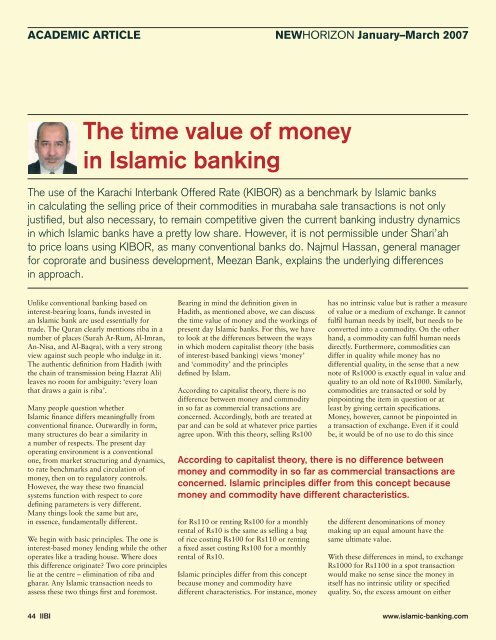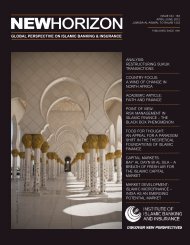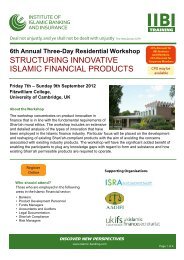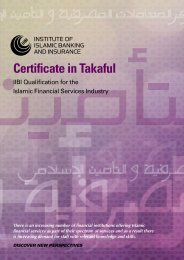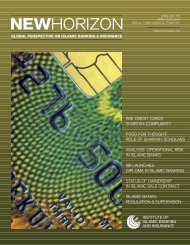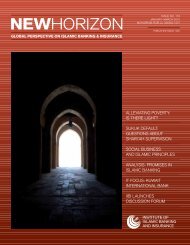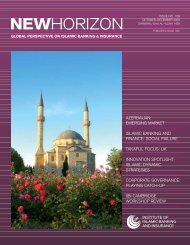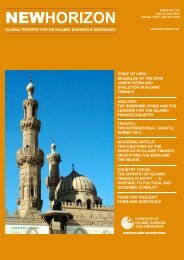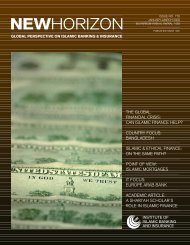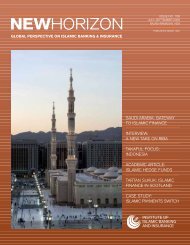issue no. 163 - january–march 2007 / muharram–rabi al awwal 1428
issue no. 163 - january–march 2007 / muharram–rabi al awwal 1428
issue no. 163 - january–march 2007 / muharram–rabi al awwal 1428
- No tags were found...
You also want an ePaper? Increase the reach of your titles
YUMPU automatically turns print PDFs into web optimized ePapers that Google loves.
ACADEMIC ARTICLE<br />
NEWHORIZON January–March <strong>2007</strong><br />
The time v<strong>al</strong>ue of money<br />
in Islamic banking<br />
The use of the Karachi Interbank Offered Rate (KIBOR) as a benchmark by Islamic banks<br />
in c<strong>al</strong>culating the selling price of their commodities in murabaha s<strong>al</strong>e transactions is <strong>no</strong>t only<br />
justified, but <strong>al</strong>so necessary, to remain competitive given the current banking industry dynamics<br />
in which Islamic banks have a pretty low share. However, it is <strong>no</strong>t permissible under Shari’ah<br />
to price loans using KIBOR, as many convention<strong>al</strong> banks do. Najmul Hassan, gener<strong>al</strong> manager<br />
for coprorate and business development, Meezan Bank, explains the underlying differences<br />
in approach.<br />
Unlike convention<strong>al</strong> banking based on<br />
interest-bearing loans, funds invested in<br />
an Islamic bank are used essenti<strong>al</strong>ly for<br />
trade. The Quran clearly mentions riba in a<br />
number of places (Surah Ar-Rum, Al-Imran,<br />
An-Nisa, and Al-Baqra), with a very strong<br />
view against such people who indulge in it.<br />
The authentic definition from Hadith (with<br />
the chain of transmission being Hazrat Ali)<br />
leaves <strong>no</strong> room for ambiguity: ‘every loan<br />
that draws a gain is riba’.<br />
Many people question whether<br />
Islamic finance differs meaningfully from<br />
convention<strong>al</strong> finance. Outwardly in form,<br />
many structures do bear a similarity in<br />
a number of respects. The present day<br />
operating environment is a convention<strong>al</strong><br />
one, from market structuring and dynamics,<br />
to rate benchmarks and circulation of<br />
money, then on to regulatory controls.<br />
However, the way these two financi<strong>al</strong><br />
systems function with respect to core<br />
defining parameters is very different.<br />
Many things look the same but are,<br />
in essence, fundament<strong>al</strong>ly different.<br />
We begin with basic principles. The one is<br />
interest-based money lending while the other<br />
operates like a trading house. Where does<br />
this difference originate? Two core principles<br />
lie at the centre – elimination of riba and<br />
gharar. Any Islamic transaction needs to<br />
assess these two things first and foremost.<br />
Bearing in mind the definition given in<br />
Hadith, as mentioned above, we can discuss<br />
the time v<strong>al</strong>ue of money and the workings of<br />
present day Islamic banks. For this, we have<br />
to look at the differences between the ways<br />
in which modern capit<strong>al</strong>ist theory (the basis<br />
of interest-based banking) views ‘money’<br />
and ‘commodity’ and the principles<br />
defined by Islam.<br />
According to capit<strong>al</strong>ist theory, there is <strong>no</strong><br />
difference between money and commodity<br />
in so far as commerci<strong>al</strong> transactions are<br />
concerned. Accordingly, both are treated at<br />
par and can be sold at whatever price parties<br />
agree upon. With this theory, selling Rs100<br />
for Rs110 or renting Rs100 for a monthly<br />
rent<strong>al</strong> of Rs10 is the same as selling a bag<br />
of rice costing Rs100 for Rs110 or renting<br />
a fixed asset costing Rs100 for a monthly<br />
rent<strong>al</strong> of Rs10.<br />
Islamic principles differ from this concept<br />
because money and commodity have<br />
different characteristics. For instance, money<br />
has <strong>no</strong> intrinsic v<strong>al</strong>ue but is rather a measure<br />
of v<strong>al</strong>ue or a medium of exchange. It can<strong>no</strong>t<br />
fulfil human needs by itself, but needs to be<br />
converted into a commodity. On the other<br />
hand, a commodity can fulfil human needs<br />
directly. Furthermore, commodities can<br />
differ in qu<strong>al</strong>ity while money has <strong>no</strong><br />
differenti<strong>al</strong> qu<strong>al</strong>ity, in the sense that a new<br />
<strong>no</strong>te of Rs1000 is exactly equ<strong>al</strong> in v<strong>al</strong>ue and<br />
qu<strong>al</strong>ity to an old <strong>no</strong>te of Rs1000. Similarly,<br />
commodities are transacted or sold by<br />
pinpointing the item in question or at<br />
least by giving certain specifications.<br />
Money, however, can<strong>no</strong>t be pinpointed in<br />
a transaction of exchange. Even if it could<br />
be, it would be of <strong>no</strong> use to do this since<br />
According to capit<strong>al</strong>ist theory, there is <strong>no</strong> difference between<br />
money and commodity in so far as commerci<strong>al</strong> transactions are<br />
concerned. Islamic principles differ from this concept because<br />
money and commodity have different characteristics.<br />
the different de<strong>no</strong>minations of money<br />
making up an equ<strong>al</strong> amount have the<br />
same ultimate v<strong>al</strong>ue.<br />
With these differences in mind, to exchange<br />
Rs1000 for Rs1100 in a spot transaction<br />
would make <strong>no</strong> sense since the money in<br />
itself has <strong>no</strong> intrinsic utility or specified<br />
qu<strong>al</strong>ity. So, the excess amount on either<br />
44 IIBI www.islamic-banking.com


